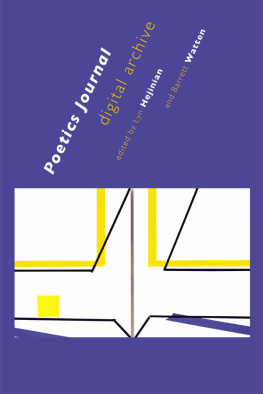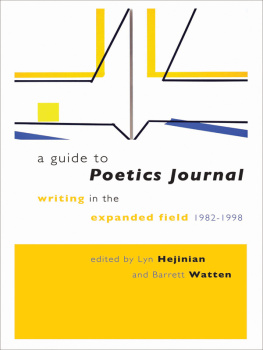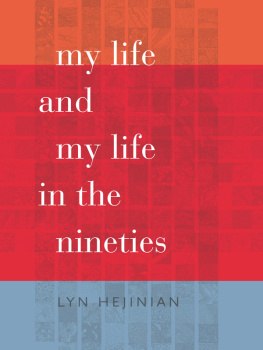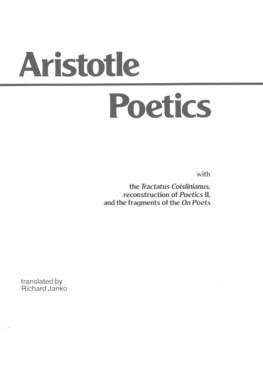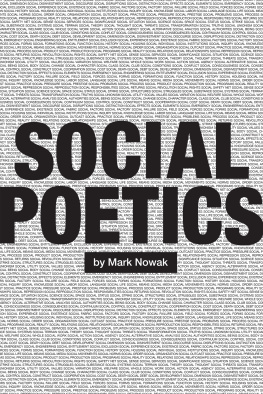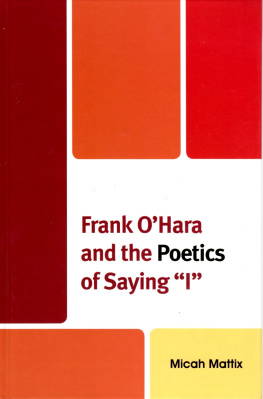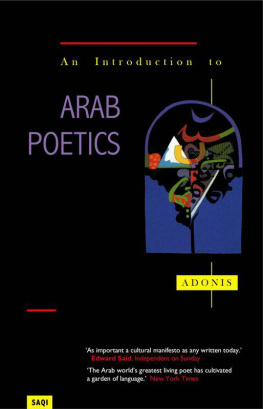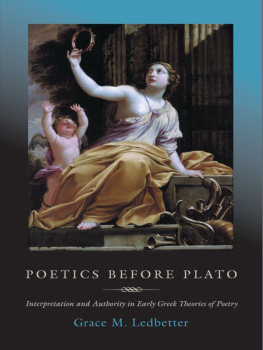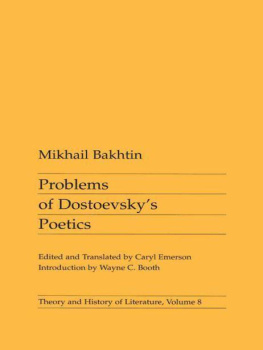
Poetics Journal Digital Archive
Poetics Journal Digital Archive
with the copublication of A Guide to Poetics Journal
Edited by Lyn Hejinian and Barrett Watten
WESLEYAN UNIVERSITY PRESS
Middletown, Connecticut
Wesleyan University Press
Middletown CT 06459
www.wesleyan.edu/wespress
2014 Lyn Hejinian and Barrett Watten
All rights reserved
Manufactured in the United States of America
Ebook ISBN 978-0-8195-7123-6
Publication of this book is funded by the
Beatrice Fox Auerbach Foundation Fund
at the Hartford Foundation for Public Giving.
Cover illustration: Marjorie Welish. Indecidability of the Sign: Frame 23, acrylic on panels, 2007, 18 28.
publication of this book is funded by the
BEATRICE FOX AUERBACH FOUNDATION FUND
at the Hartford Foundation for Public Giving
Contents
How to Use This Archive
This archive is the second of a two-part publication, coedited by Lyn Hejinian and Barrett Watten, that re-presents work from the ten issues of Poetics Journal that appeared from 1982 to 1998.
The first component of our project, A Guide to Poetics Journal: Writing in the Expanded Field, 198298, is an anthology that includes thirty-six articles selected from the run of the journal, organized in three chronological sections, along with comprehensive introductions by both editors, contextualizing headnotes, publication history, links, keywords, abstracts, and bibliographies for each article.
The second component, Poetics Journal Digital Archive, is a resource that re-publishes virtually all of the articles originally published in Poetics Journal, organized alphabetically by author and in searchable form. Poetics Journal Digital Archive features indexes by contributors, original publication volume, and keywords.
A reflexive and complementary relationship exists between the two publication formats and media. With its inclusion of constellations of thirty-six additional texts that may be accessed only in the Digital Archive, the print Guide to Poetics Journal consistently references, and is formally constructed in relation to, that Archive.
Together, these components comprise a print/digital publication that we hope will make the best use of both media, drawing on the possibilities of print and digital formats.
In the Archive, works were removed from their original sequence and thematic contexts and organized alphabetically by author. Our intent was to render the articles easy to find, but in reading through the resulting pages we discovered remarkable connections that we had not anticipated. The resulting Archive may be seen as a matrix for making connections, not merely an archive of already published work. We hope that this reorganization will allow readers to discover these writings again, and to make new constellations and threads between them. Some of the essays published in the print Guide are abridged versions of the originals, and readers will find the complete versions in this Archive. Although many of the essays were revised and included in later volumes by their authors, we have chosen to preserve versions that are as near as possiblewith the exception of minor editing and correctionsto their original appearance. In almost every case, we have resisted any impulse to revise or rewrite. Nearly all the articles published over the life of Poetics Journal are included, with the exception of three essays that their authors chose not to reprint.
Each article in the Guide and Archive has been assigned two to four keywords, and a keyword index in the Archive provides links to all of the published texts arranged by keyword. These keywords are given at the end of each article, and the reader may click on links to discover more content associated with each keyword. For example, at the end of Rae Armantrouts Mainstream Marginality appear links to four entries in the keyword index: lyric poetry; genre; ideology; and readings. These links will take the reader to a keyword index where related works may be found. As well, indexes by author and volume link to the individual works. Readers are thus offered numerous ways of constructing relationships between the essays published in Poetics Journal.
The construction of new meanings has always been the project of Poetics Journal and, we hope, will continue in these editions. We encourage readers to build constellations between and among the materials we have assembled here, also making full use of the bibliographies of book-length collections and anthologies of poetics and poetry we have provided. In this wayby constructing new relationships and discovering hitherto unnoticed onesthe work of Poetics Journal may continue and expand.
Our hope is that the combined publication of the guide and archive will provide a model for the continued circulation and accessing of writing in poetics in a way that foregrounds the historical contexts for their production as well as their relation to each other. The writing that appeared in Poetics Journal reflects the development of a range of creative and critical approaches in avant-garde poetry and art over two decades. In making this content newly available, we hope to preserve the generative enthusiasm for innovative writing and art it represents, while encouraging new uses and contexts.
Lyn Hejinian and Barrett Watten
Poetics Journal Digital Archive
Culture doesnt account for actual practice (Bill Berkson). I write with words which are given me. If it werent for certain community consensus as to the meanings and usages of words, words would be nonsense. Language, then, deeply is discourse: when I use language, I am given meaning and I give meaning back to the community. Culture is one way by which a community attempts to bring its past up out of senselessness and to find in dream and imagination possibilities for action. When culture isnt this, theres something wrong in the community, the society.
Political, economic, and moral forces are major determiners of meanings and values in a society. Thus, when I use words, any words, I am always taking part in the constructing of the political, economic, and moral community in which my discourse is taking place. All aspects of languagedenotation, sound, style, syntax, grammar, etc.are politically, economically, and morally coded. In this sense, theres no escaping content. Whenever someone, the literati, the professors declare that there is such a thing as total ornament, that art is pure, what they are saying is that the rich own culture, discourse, and probably the world. If this seems like a non sequitur, you figure it out.
Whenever I engage in discourse, I am using given meanings and values, changing them and giving them back. A community, a society is always being constructed in discourse if and when discourseincluding artis allowed. Societies whose economies are set, fascist ones for instance, place little or no emphasis on free discourse, on art. Of course art, then, is trivial. The rich want to stay rich.
Language always occurs in the present because it makes the present, because its active.
We are now, in the United States and in England, living in a world in which ownership is becoming more and more set: the rich stay rich; the poor stay dead. Death-in-life. The only social mobility left occurs in terms of appearance: things no longer change hands. But fashion is not purely ornamental: it is political. All signs nowadays point either to the world of the haves or to the homeless Chicanos on the L.A. downtown streets. There is no more right-wing versus working class: there is only appearance and disappearance, those people who appear in the media and those people who have disappeared from the possibility of any sort of home. In such a society as ours the only possible chance for change, for mobility, for political, economic, and moral flow lies in the tactics of guerrilla warfare, in the use of fictions, of language. Postmodernism, then, for the moment, is a useful perspective and tactic. If we dont live for and in the, this, moment, we do not live.
Next page
